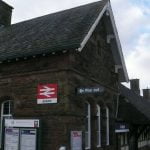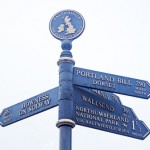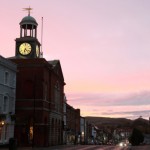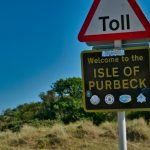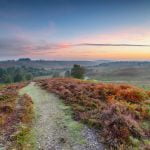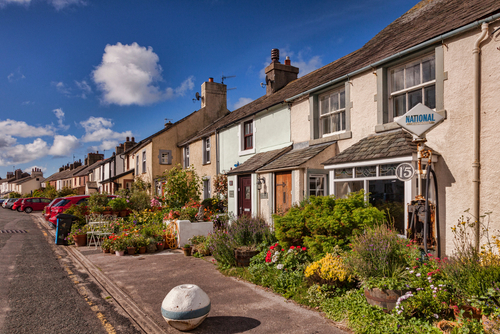
Ravenglass in Brief
Ravenglass is a small village located on the West Cumbrian coast in Northwest England. It lies between the towns of Barrow-in-Furness and Whitehaven at the confluence of the rivers Esk, Mite and Irt. It also happens to be the only coastal settlement in that lies within Lake District National Park. However, its main claim to fame must be as the terminus on the narrow-gauge Ravenglass and Eskdale Railway.
A Fleeting History
Roman Times
Ravenglass is known to date back to at least the 2nd century. It served as an important Roman naval base and regional supply centre for the whole of Northwest England. The town was also instrumental in the defense of the area against the Scots. For many years the busy port was thought to have been given the Roman name of Glannaventa. However, recently found archaeological evidence suggests that Ravenglass may have actually been called Itunocelum. Nonetheless, it was occupied by the Romans for more than 300 years and housed a garrison of at least 500 soldiers. After the Romans left the area, Ravenglass was inhabited by both the Saxons and Vikings. However, over time it lost its importance and was largely forgotten.
The Name
The next significant event in the history of Ravenglass did not happen until around 1180. That’s when the name “Rengles” was first recorded, which would eventually morph into Ravenglass. There are multiple theories on the origin of the village’s name. However, none of them happen to mention ravens or glass. The mainstream view is that the village’s name is simply derived from the land on which it was built. That is to say, it was a plot of land allotted to a man called “Gles”.
Muncaster Castle
The first notable building in the area was constructed in the late 12th century. That’s when a baronial hall was built at Muncaster about a mile east of Ravenglass. The castle and its surrounding estate were owned by Benedict de Pennington of Barrow-in-Furness.
In 1208, King John granted Richard de Lucy, Earl of Egremont, a market charter for Ravenglass. From then onwards, a market was held each Saturday and a yearly fair on the festival of St. James on 5 August. By this time, mining of the local Lakeland slate was already underway, helping to make the area relatively affluent.
In 1242, Muncaster Castle was inherited by Benedict’s grandson William. The castle served as his local seat of power. Milling was already important to the area. In 1455, a large watermill was built at the castle that still operates today.
The Railway
In 1875, Ravenglass saw the opening of a 3 ft gauge railway. The 7-mile long line was built by the Whitehaven Iron Mines. Its purpose was to carry ore from Nab Gill, near the village of Boot, to the Furness Railway at Ravenglass. The mine closed in 1882 but the railway kept running for another 31 years to serve local passenger traffic. The line closed in 1913 but reopened just two years later under new ownership. This time as a 15-inch gauge railway on which model trains were tested. The line was eventually used to transport both passengers and granite from Beckfoot quarry.
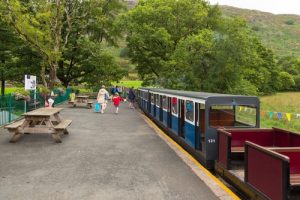
Ravenglass & Eskdale Railway at Dalemain Station (Boot). Photo credit: Tomasz Wozniac/Shutterstock.com
The Modern Era
In 1960, a local Preservation Society purchased the miniature railway that is now Ravenglass’s biggest attraction. It provides a scenic train ride that is popular with both tourists and locals alike.
With its superb scenery and heritage railway, Ravenglass attracts a good number of visitors. However, you’ll find few shops in the quiet, picturesque, residential small village.
The railway station has a small gift shop and café with a children’s play area.
Getting There
By Road
Ravenglass is located just off the stretch of the A595 that runs between Whitehaven and Dalton-in-Furness. There is no quick-route access from the motoway network to Ravenglass. Heading north on the M6 it’s approximately 47 miles to the village via the A590. The quickest way heading south on the M6 is to turn off at Penrith. The journey is approximately 57 miles via the A66 and A5086.
By Rail
Ravenglass lies on the Cumbrian West Coast Line between Lancaster and Carlisle. Trains run approximately every hour from Carlisle with a reduced service on Sundays. The service from Lancaster is much less often. Travel time from Carlisle is approximately 1 hour 40 mins and from Lancaster about 2 hours 40 mins.
Main Attractions
The Ravenglass & Eskdale Railway
The Ravenglass and Eskdale Railway is one of the oldest and longest narrow gauge railways in the UK. It’s affectionately known locally as ‘La’al Ratty’. (The word “la’al” means “little” in the Cumbrian dialect.). The 7-mile line was originally used to transport minerals mined from Boot. However, it is now the area’s biggest tourist attraction. Both diesel and steam trains operate.
Ravenglass Roman Bath House
It has to be said that the site of Ravenglass’s second-century Roman Bath House is pretty small. However, the actual structure is amongst the tallest Roman remains in the country. Thus, if you’re in the area – it’s certainly worth a visit!
Muncaster Castle
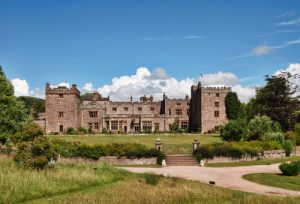
The impressive Muncaster Castle. Photo credit: Kevin Eaves/Shutterstock.com
Muncaster Castle is a Grade I listed building that dates back to 1208. There are fantastic views of the surrounding countryside from the Castle. It’s thought to stand on the foundations of the old Roman fort. You can take a guided tour of what is claimed to be one of the country’s most haunted buildings. The stunning gardens house a maze, a children’s play area, and an impressive collection of birds of prey at its Owl and Hawk Centre.
Hiking
The relatively remote, picturesque area means Ravenglass has plenty to offer for anyone interested in doing a bit of hiking. One of the most popular walks is the 10.5-mile hike to the Hardknot Roman Fort. The ascent of the 758 ft high Muncaster Fell is another favourite local walk.
Did You Know?
Ravenglass is reputed to be the birthplace of Saint Patrick.
Thinking of Moving?
Almost all properties in Ravenglass are either detached or semi-detached houses. They sold for an overall average price of £215,500 over the last year (Sep 2022). Most sales were for semi-detached properties which fetched an average price of £208,000. Detached properties sold for an average of around £230,000.
The overall sold price of properties in Ravenglass over the last year (up to Sep 2022) was about 8% down from the previous year.
Header image credit: travellight/Shutterstock.com
So that’s it! That’s our quick guide to the lovely Cumbrian village of Ravenglass. A big fan of Cumbria? If so, why not take a look at some of our other ‘Five Minute Location Guides’ for Cumbria? Or, maybe you’d like to have a go at our Big Fat Cumbrian Quiz?
